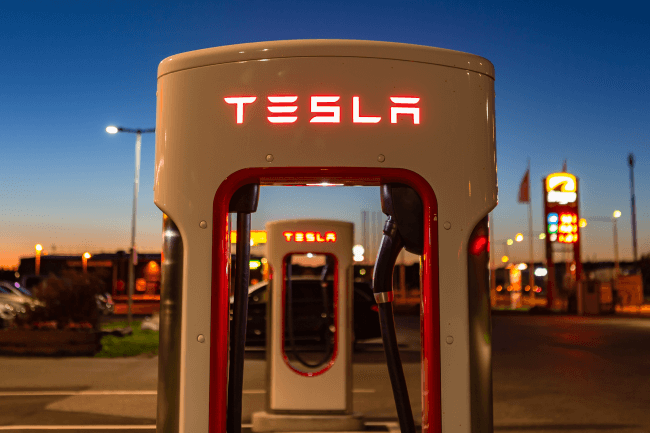Tesla's Plan to Reduce SiC Usage in Lower-End Vehicles by 75%
Insights | 08-03-2023 | By Robin Mitchell
Recently, Tesla announced that a new powertrain being developed for lower-end Electric Vehicles (EVs) will reduce the use of Silicon Carbide (SiC) by 75%, raising concerns surrounding the future of SiC in the EV market. SiC presents a viable option for EVs due to its high power efficiency, reducing losses in both voltage and current, and its ability to reduce the size and weight of the motor while increasing thermal efficiency. Tesla's announcement could cause disruption in the SiC market as other manufacturers may follow suit in reducing the use of SiC in their EVs. Why has SiC presented a viable option for EVs, what has Tesla announced, and could this cause disruption in the SiC market?
Why has SiC presented itself as an excellent power option for engineers?
Silicon Carbide (SiC) has been around for decades, but it has only been in the last few years that it has seen its development accelerate. As the power requirements of DC systems continue to increase, older technologies such as IGBTs suffer from numerous challenges that make them difficult to use. One such challenge is the need for improved energy efficiency in switching devices.
The most obvious reason for energy efficiency comes from improved battery life and reduced CO2 emissions (assuming that power is drawn from fossil fuels). However, improving the energy efficiency of a switch is also critical for enhancing thermal characteristics, as lower losses directly translate to less heat being generated. If a switch can be made to run cooler, it can also be made smaller, thus miniaturising a design.
Compared to standard silicon technologies, SiC offers engineers countless opportunities arising from its almost 5x greater thermal conductivity, 10x greater breakdown voltage, and 3x greater bandgap. Simply put, these characteristics make SiC devices highly suited for high voltage, high power applications. At the same time, SiC is more suited for operating at higher switching frequencies, which helps reduce the size of passives such as inductors, thereby significantly reducing the weight of devices such as power converters.
As such, it only makes sense that EV manufacturers, in particular, have gravitated towards SiC devices over Si. By making powertrains smaller and more energy efficient, more powerful motors can be used, vehicle range can be extended, and more importantly, higher DC voltages can be used, which reduces power losses in cables and supports faster charging.
Tesla moves to reduce SiC usage by 75% in new vehicles
Recently, Tesla announced that it will be looking to reduce the amount of SiC technology used in its next line of powertrains by up to 75%. Currently, higher-end models of Tesla vehicles come with 48 SiC devices, but the new powertrains aim to use just 12. While this may seem like Tesla is moving away from SiC, it should be stated that the next line of powertrains being developed targets lower-end markets with vehicles with reduced performance. By reducing the performance and capabilities of the next range of vehicles, their price can be dramatically reduced, helping to introduce EVs to more consumers.
According to Aher Test Systems, the announcement from Tesla may not be as dire for the SiC industry as many believe. They stated that while the number of SiC devices may reduce by 75%, the die size will likely increase, resulting in the same number of wafers being produced. Thus, the news from Tesla could indicate a desire to head towards custom SiC devices, or at least custom SiC packages that provide better performance in Tesla vehicles. It was also mentioned by Aher Test Systems that they suspect the new SiC devices will have twice the current capacity (100A over the current 50A) as a result of their larger size.
Finally, it is believed that the current use of SiC devices in higher-range vehicles will not change, thus ensuring the success of SiC in the automotive industry. As Tesla will be exploring custom packages, it could help encourage custom SiC devices and packaging technologies from companies including STMicroelectronics, Infineon, and Wolfspeed.

Could this news be bad for SiC devices in general?
Despite some media outlets panicking about this news, it is unlikely that the fate of SiC is at risk. If anything, it is rather bold to assume that the fate of SiC lies in the hands of Tesla, a company that has faced numerous challenges surrounding its software and the repeated promises of full self-driving capabilities. Of course, Tesla has been instrumental in popularising EVs, but now that other automakers are catching up, it is likely that the success of SiC will depend on those manufacturers.
However, there are alternative technologies to SiC, one being GaN. While GaN suffers from thermal conductivity issues, it has a much higher breakdown voltage, bandgap, and electron saturation velocity, making it ideal for high-power use. But, GaN devices would be significantly large and require more intensive heat removal systems.
Overall, SiC continues to prove its worth in high-voltage applications, and even if Tesla goes bust, SiC will continue to play a critical role in future applications.

